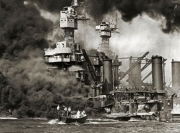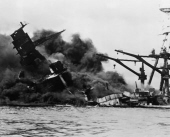Pearl Harbor: In Memory and Present
Pearl Harbor: In Memory and Present
Read on for a collection of articles and resources explaining the context of Japan's attack on Pearl Harbor and its lasting significance today.
Pearl Harbor Images:
Photograph of US naval ship USS West Virginia being sunk by Japanese airplanes on Dec. 7, 1941.
Iconic image of the USS Arizona sinking at Pearl Harbor on December 7, 1941.
Banner Headline from the New York Times of December 8, 1941, announcing Japan's attack on the United States.
Contextualizing the Attack:
Map of the Japanese Empire in 1943
Essay: An Introduction to Understanding Imperialism
- Historian Jonathan Lipman provides an overview of Japanese political history during this period, situating it within the larger context of East Asia and Japan's views towards East Asia.
Essay: An Overview of Japanese Imperialism
- Imperial Japan is a complex period in which Japan both influenced and was influenced by global cultural, political and technological developments. Unfortunately, it is also a period that is too often oversimplified, frequently devolving into rigid dichotomies such as “Westernization” versus “Traditionalism” or good vs. evil.
- Students will examine the significance of the Russo-Japanese War as a critical event in Japanese, as well as world history through comparisons of the events’ portrayal in contemporary traditional and emerging media; from woodblock prints, to photographs and film.
The End of WWII:
Picture of Tokyo illustrating the physical damage created by intensive bombing, especially in March 1945.
Signing of the surrender document at the end of World War II on board the USS Missouri by Japanese Foreign Minister Mamoru Shigemitsu, Sept. 2, 1945.
Image of the surrender ceremony with original picture caption.
The Aftermath:
Citizens in Tokyo wait in line for food rations in September, 1945, as hunger and poverty caused tremendous suffering.
Rations being distributed to people in need of food in July, 1946.
Essay: The Allied Occupation of Japan
- Peter Frost, Frederick L. Schuman Professor of International Studies Emeritus at Williams College and Visiting Professor of History and Senior Research Associate at the Croft Institute for International Studies at the University of Mississippi, gives an overview of the reforms and examines the controversy surrounding an especially contentious period in Japanese history, the Allied Occupation.
Essay: Postwar Japan: 1952-1989
- Professor Peter Frost examines the positive and negative reactions to the changes that occurred in postwar Japan, specifically in regard to the quality of life.
Lesson Plan: Japan in the World Since 1945
- Lesson exploring Japan's politics after the Allied Occupation, in particular the close but conflicted relationship with the United States, the sometimes strained relations with China and South Korea, and Japan's military policy.










